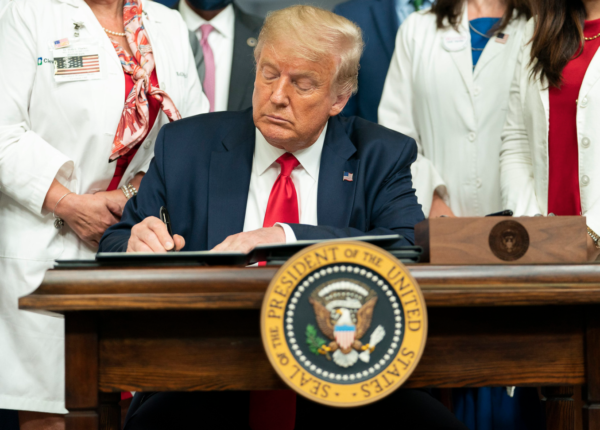
The rhetoric President Trump used in unveiling a set of new executive orders on prescription drug pricing could not have been more bloated, nor the substance of those measures so skimpy. On Friday, the president proclaimed in dramatic fashion that the four “bold and historic” executive orders would be of “help for our great seniors,” achieve things “nobody thought could be done” and result in “massive reductions” to prescription drug prices.
That it took almost four years for the president to issue a set of orders addressing one of his highest campaign priorities in 2016 is suspect in and of itself. They were unveiled in the midst of a pandemic that has disproportionately imperiled seniors as Trump’s poll numbers with the crucial 65+ voting bloc are plummeting. It is hard not view these late-coming executive orders as a ploy to win back some of the senior vote rather than as a set of serious policy proposals.
Politico reported this weekend that the president’s orders are “rife with limitations,” despite his inflated rhetoric:
“The orders are not immediately enforceable. Health officials have been working on ways to implement some of the proposals — namely guidelines for states to implement importation plans. But it’s is unlikely that any could be finalized before the November presidential election…” – Politico, 7/24/20
Clearly, if the President wanted “bold” action on prescription drugs, he would have backed H.R. 3, The Elijah Cummings Lower Drug Costs Now Act, which allows the Medicare program to negotiate drug prices directly with Big Pharma. Not only did the president not embrace this legislation, he did not include Medicare price negotiation – the single most effective solution to the price gouging that affects so many of our seniors – in his executive orders.
“Any proposal that doesn’t include Medicare price negotiation can’t be taken seriously, because any serious policy effort must include it to address the underlying problem of price gouging.” – Max Richtman, president and CEO of the National Committee, 7/24/20
If he were serious about reducing prescription prices, the president could have pushed the GOP-controlled Senate to pass the Grassley-Wyden bill, which does not include price negotiation but represents a solid step toward controlling drug costs through inflation-indexing. Besides offering some tepid support for the bill, the president never agitated for its passage, instead claiming that he has been “waiting for Congress” to take action.
Price Caps
The first executive order would revive a long-standing proposal to link what Medicare pays for prescription drugs to the prices in other countries, which sounds like a sweeping action on face. But the order won’t go into effect immediately (if ever), because the order includes an escape clause for Big Pharma to come up with an alternative of its own.
Rebates
The second order would eliminate the rebates that pharmaceutical companies pay to insurance companies – which Stat News refers to as a “previously abandoned” plan.” The catch here is that the order would not kick-in if it affects insurance premiums.
Drug Importation
The third order instructs the Department of Health and Human Services to facilitate “grants to individuals of waivers of the prohibition of importation of prescription drugs,” meaning that individual Americans (not the federal government) could buy drugs from Canada and other countries.
Insulin and Epi-pens
The fourth order requires federal community health centers to pass discounts for insulin and epi-pens directly to patients. As Politico reports, the order only applies to approximately 1,000 community health centers nationwide, “not to hospitals that are frequently flagged as diverting the discounts away from patients toward other programs.”
Hitting Big Pharma with a Feather
The executive orders are consistent with the administration’s overall approach to soaring prescription drug prices, which has been piecemeal at best, disingenuous at worst. (Some of the president’s previous actions have been tossed out by the courts, others postponed or abandoned.) The president may talk tough about taking on Big Pharma, but his executive orders seem designed to strike the industry with the force of a feather.
Hardly “revolutionary” or “historic,” the latest executive orders “direct his administration to begin the normal, notoriously slow regulatory processes needed to reform the existing system,” Stat News observes.
National Committee president Max Richtman says that “seniors suffering from soaring prescription prices will not be fooled by grandiose pronouncements at a press conference that appear to be a ‘Hail Mary’ pass during an election year.”
Like previous Trump administration actions on this issue, the latest round of executive orders are too little, too late, and too weak to remedy the scourge of prescription price gouging.


